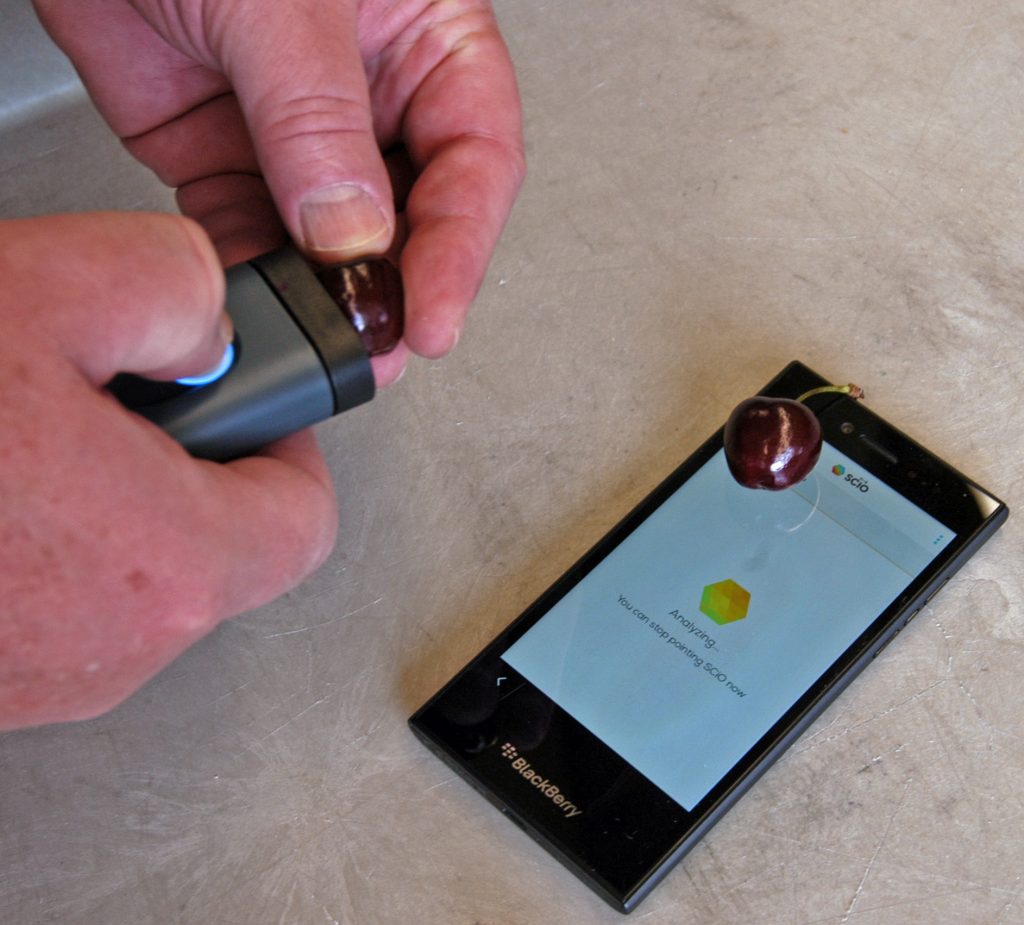
Features
Fruit
Production
Canadian cherries in the spotlight: New tools will help growers pick the best markets
July 24, 2018 By AAFC
 SCiO taking a measurement on a cherry; it is one of the commercial optical spectrometers Dr. Toivonen’s team are using to develop their models. AAFC
SCiO taking a measurement on a cherry; it is one of the commercial optical spectrometers Dr. Toivonen’s team are using to develop their models. AAFCShipping cherries overseas is a high stakes game – every container carries approximately $100,000 of fruit. International consumers are becoming increasingly picky and buyers will only accept high quality cherries at port. Growers and packers are making it a top priority to ensure cherries make the journey in top form, impressing both international buyers and consumers.
Fortunately, advances in science are making it possible to measure cherries’ quality while they are still hanging on the tree, without damaging any in the process.
A team of researchers at Agriculture and Agri-Food Canada (AAFC) in Summerland is working with mobile hand-held optical spectrometers to develop models to precisely gauge the quality of cherries, and predict their firmness and flavour after storage or shipping.
The research team
Dr. Peter Toivonen leads the Postharvest Physiology program at AAFC’s Summerland Research and Development Centre, which includes research technician Brenda Lannard and biologist Changwen Lu.
Together, they are fine-tuning models using specific commercial spectrometers to make this technology useful for Canadian cherry producers.
The team is determining the best values for fruit quality and storability for cherry varieties, including Lapins, Staccato, Sweetheart and many others that are grown commercially.
The work includes fine-tuning and expanding the use of the technology by developing specific protocols for working under a variety of conditions while ensuring consistent and meaningful readings.
The team is also working to identify any limitations to the technology before transferring it to end-users. As with other technologies, users – most likely skilled quality assurance or field service staff – will need training before putting these devices to work in the field. Working with industry to properly implement the technology will be the key to success.
What is the impact to growers?
Using hand-held spectrometers, in combination with knowledge generated from Dr. Toivonen’s research, will give cherry growers precise data on their crop’s ‘best before’ date.
“Being able to reliably measure the maturity and quality of cherries, without sacrificing any of that crop to sampling, will save hundreds of thousands of dollars a year on container shipment claims for the industry,” estimates Dr. Toivonen.
Consumers’ expectations are high and if Canadian growers can improve their reputation for consistent high quality and flavour, the industry will benefit. Growers could see a 10-20% increase on returns thanks to improved consistency in quality.
“People are doing this work in other countries. If we are not part of it, we are behind,” advises Dr. Toivonen. Luckily, his team is working to keep the industry on the leading edge and consumers happy.
A closer look at the science: Q&A with Dr. Toivonen
What are optical spectrometers?
An optical spectrometer is a scientific instrument that emits light and measures how much of that light reflects back to the instrument. You hold the device against a cherry, it shines light on the surface of the intact fruit, and it measures the amount of light of each wavelength reflected back. The reflected light depends on the chemical composition of the fruit. Spectrometers were once cumbersome pieces of equipment, suited only for laboratory use, but now they are designed specifically for use in orchards.
What is dry matter?
Dry matter is what’s left in the fruit after all the water is removed. In cherries, dry matter is equivalent to sugar content, and is a good indicator of ripeness, quality after storage and flavour.
A grower who knows the dry matter content of their cherries can determine how well that fruit will do in storage, and decide which fruit to sell immediately and which to store or ship internationally. In short, using dry matter to make decisions on storage, shipping and market selection could lead to a consistent supply of crisp and delicious cherries from Canadian growers.
How do you measure dry matter?
The ‘old fashioned way’ of measuring dry matter isn’t practical for an orchard operation. You cut fruit into thin slices, weigh it and bake it at 60oC in an oven for two to three days until all the water is removed, then weigh it again. Your sample size is limited by oven space, samples are tedious to process, and valuable time is lost waiting for results. That could mean missing the best time for harvesting and shipping your cherries.
After the team completes validation of the scientific models for commercial spectrometers, growers will have a tool that can produce instant dry matter readings on as much fruit as needed without damaging any of it.
Print this page